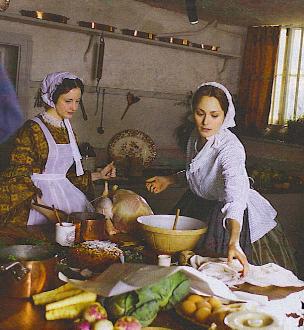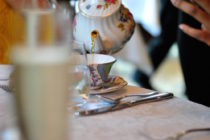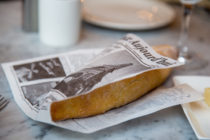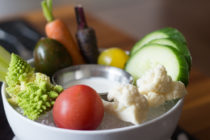Once upon a time matters of food and cooking were under the sole purlieu of the women in the household; and it was in the home kitchen that people of the female persuasion had best (and sometimes only) opportunity to express their creativity.
With all that culinary cutting up going on, it naturally follows that somewhere along the line some bright lady would get the bright idea to write down the particulars of food preparation. It might be difficult today to imagine a world without written recipes, but books about cooking penned by a female hand (and written strictly to aid mavens of hearth and home) did not come along until the 18th century.
The following article by contributor Micki McClelland spotlights some of the women who picked up a pen and a saucepan.
When Hannah Glasse published The Art of Cookery Made Plain and Easy in 1747, not only did she lift the veil on what had previously been an exclusive men’s club reserved only for professional chefs, but she let the air out of haughty phraseology in cooking instruction (or as one reviewer said, “out went French nonsense”) and did as promised: She made her recipes plain and easy. She tossed out arcane code words such as “pass it off brown” and wrote simply “fry it in butter.”
Certainly Glasse brought a needed tool to housewives all over England, but her effort also pioneered the way for cookbooks to go beyond recipes, stretching the prose to include personal memoir, opinion and cultural background.
In his book Choice Cuts: A Savory Selection of Food Writing from Around the World and Throughout History, contemporary American journalist Mark Kurlansky wrote: “The history of female food writing became the story of the long, slow struggle toward women’s emancipation.” Curious to think that in the old masculine-dominated literary world, to break the silence of the fairer sex all a girl had to do was break an egg and then write about it.
When Elizabeth Raffald, a sharp-minded and energetic woman, wrote The Experienced English Housekeeper in 1769, she based her advice on the years she had spent working as domestic servant for the upper-class Warburton family at their manor house Arley Hall in Cheshire. Considering what the lady did for the family, it’s doubtful she had time to sleep, much less compose material for a future book.
Imagine Raffald for one 24-hour period at Arley Hall. There she is bustling around before dawn seeing to breakfast; then out to purchase food for the kitchen staff to prep for lunch, tea and dinner; then right alongside the kitchen staff pickling foods, making wine, roasting meats; then overseeing lunch; setting the grand table for dinner; bringing in flowers for table decorations and getting utensils, plates, goblets placed; whipping up cakes for tea time; instructing the scullery maids; producing the food courses for dinner and fetching the wine. And sometime during the day or night, she still found time to flirt with the gardener, whom she eventually married.
Last year Houston’s Museum of Fine Arts Rienzi House presented a symposium about Raffald. Within the historical lecture notes about her life, it was revealed that after leaving Arley Hall, the entrepreneurial (and seemingly inexhaustible) Raffald opened a dessert shop where she cooked up and presented “creams, possets, jellies, flummery and lemon cheese cakes;” started a cooking school and a servant’s registry; helped launch a newspaper; ran the King’s Head Inn; gave birth to 16 daughters; wrote her book wherein one of the recipes instructs how to roast “large eels with a pudding in the belly;” and frequently had to skip over to the local jailhouse to bail out her drunken wastrel of a husband.
The next notable achievement by a female food writer came in 1845 when a shy, sweet-tempered Victorian spinster named Eliza Acton published her book Modern Cookery for Modern Families. After spending years in her kitchen trying out each recipe before compiling her manuscript, Acton’s cookbook was the first to list ingredients at the top of recipes, first to provide measurements and the first to suggest cooking times. At the time, the concept of finding easy-to-read cooking instructions inside a book was mind-boggling.
In her youth Acton had written and published romantic poetry. But it was the revolutionary cookbook that brought her fame: One modern-day female chef has proclaimed Acton “the best writer of recipes in the English language.” Devoting 37 pages to soup alone and providing some offbeat recipes such as oyster sausages, pickled nasturtiums and raisin wine, it was rumored that some of Acton’s best recipes were pilfered by Queen Victoria, who passed them off to guests at her royal table as of her own creation.
What was not a rumor but a bald-faced theft came along 16 years after the publication of Acton’s comprehensive tome. In a book entitled Mrs. Beeton’s Book of Household Management, the self-same Isabella Beeton plagiarized more than 100 of Acton’s recipes, copying them verbatim into her “original” work.
A few notes about Mrs. Beeton: Mrs. Beeton loathed cooking and Mrs. Beeton detested the kitchen. To lend proof to this assessment of Mrs. Beeton, one only need remember that she suggested boiling pasta for an hour and a half before serving.
 It might also be said that Mrs. Beeton hated food – that is, certain kinds of food, especially food that smacked of exotic, foreign influence. Of mangoes she opined the fruit could only be enjoyed by people who like to drink turpentine; potato-eaters were those who craved to fill their systems with narcotics; tomatoes were so vile that even the smell of stewing could drop a perfectly healthy housewife into a dead faint. She declared not only would she never eat pâté de foie gras, but would also pointedly snub anyone she saw eating “the dense and slippery organ.”
It might also be said that Mrs. Beeton hated food – that is, certain kinds of food, especially food that smacked of exotic, foreign influence. Of mangoes she opined the fruit could only be enjoyed by people who like to drink turpentine; potato-eaters were those who craved to fill their systems with narcotics; tomatoes were so vile that even the smell of stewing could drop a perfectly healthy housewife into a dead faint. She declared not only would she never eat pâté de foie gras, but would also pointedly snub anyone she saw eating “the dense and slippery organ.”
Still, her book does instruct how to fold a napkin, cautions parents to keep a keen eye out for drunken nannies, derides independent women who fly the coop and (copped directly from Acton) tells how to roast a spitted hog over an open fire.
From the tone of her writing (as well as in parts of the book that were clearly written by someone else – someone with a perceptibly masculine hand), the assumption can be made that running a Victorian household was a “grave and cheerless business.” Book publishing, however, proved not to be so cheerless. After hitting the booksellers’ stalls, Mrs. Beeton’s oeuvre sold more than 2 million copies in the first eight years after publication.
Elizabeth Robins Pennell could not cook. Like most upper- and middle-class women of her day, she rarely visited the kitchen, leaving meal preparation to a staff of servants.
But endowed with a lively mind, a quirky sense of humor, a passion for writing and a curiosity that used both research and sharp observation to learn “the language of cooking,” she began penning culinary essays for a London newspaper, the Pall Mall Gazette, that were collected and published in 1896 in her first book The Feast of Autolycus: The Diary of a Greedy Woman.
This was one wacky tome. Not so much crazy-in-the-head writing, but instead wildly eccentric, especially for the time. From the modern-day perspective, it could be said that Pennell kicked over the table of conventional self-deprivation practiced by females at mealtime – ladies were expected never to appear to be enjoying food – and suggested the sorority of starving sisters instead grab a fork and adopt the equivalent of: “Speak up Girls, and demand a steak as big and juicy as the one on his plate.”
Being the Age of Unreasonable Restraint, women in those days were expected to eat lightly in order to attract and inspire romantic dalliances with the opposite sex. As Pennell put it in her introduction to the book: “A healthy appetite passes for a pact with the devil. Silly matrons and maidens toy tenderly with a chicken wing or unsubstantial wafer; and the pleasure of eating is looked upon as a deep mystery, into which only men could be initiated.”
Re-issued in 1901 as The Delights of Delicate Eating, Pennell’s greedy woman was still there, but under cover of a less in-your-face title. Giving the raspberry to kitchen-phobia and feigned lack of appetite in females, the impassioned advocate for change in dining habits wrote: “All his life Velasquez devoted to his pictures, Shakespeare to his plays, Wagner to his operas: why should not the woman of genius spend hers in designing exquisite dinners, inventing original breakfasts, and be respected for the nobility of the task. For in the planning of the perfect meal there is art.”
In Chapter Two, we read what constitutes Pennell’s perfect breakfast. It is, to say the least, a mouthful. And just as annoyed as she was with her female contemporaries fussing relentlessly at their wrong-headed approach to eating, she takes off like a lyric poet when promising her delicate readers that not only will their stomachs be deeply satisfied by dining extravagantly, but their sex life will improve as well: “Accept the gospel of good living and all sexual problems will be solved.”
In paraphrase, this is Pennell’s aesthetically arranged early morning petit dejeuner, or breakfast: to begin, radishes with bread and butter; then oeufs aux saucissons (“a dish invented by angels”) that sees truffled French sausages paired with fried eggs and baked in a rich wine sauce. Up next, rognons sautés (thin slices of kidneys fried in butter) followed by côtelettes du mouton (grilled lamb cutlets served with sautéed potatoes). Then comes the salad, described as “cool and quieting,” and we are told that at center table there must be tulips arranged in an old blue china vase, which will complement the cheese course (“Suisse, of course”). The wine should be light (Pennell recommends a good Graves, as Burgundy is too heavy for breakfast), and coffee should be the best quality or don’t have it at all. Either cherry or prune liqueur should be served when you “bring out the cigarettes.” We are warned to eschew both Egyptian and Turkish cigarettes, as those brands will taint the breakfast room air with opium. Pennell suggests instead “the cleaner, purer Virginian” tobacco. And on final note, she writes: “Then smoke until all earthly troubles are smoked away.”
Her paean to the “greedy woman” was the first book to celebrate the art of cooking from the female side of the cutting board and the first to trumpet the aesthetic value of fine dining paired with sparkling, intelligent conversation. Happily for those of us who would relish an invitation to sit at Pennell’s table, a modern day audience can now sip from her golden bowl. At the turn of the 21st century (100 years after its change-of-title debut in 1901), The Delights of Delicate Eating was re-published by the University of Illinois Press.
In it we learn that Pennell detested British cooking, noting that restaurant kitchens in 1920s England made soup that was “a thick greasy mess that could only appear to the coarsest hunger”; that “a guest who doesn’t know good coffee deserves to be cast into outer darkness”; and that if we “banish the onion from the kitchen, pleasure flies with it.” Adoring Italian cooking, Pennell tells us that “in the dish of macaroni lies all of Italy for the woman with eyes to see or a heart to feel.” And she takes us to her beloved France “in a French railway carriage: a bottle of wine at your side … out the window long lines of poplars go with you toward Paris, whither you are bound to make the feast.”
During her lifeElizabeth Robins Pennell collected more than a thousand cookbooks (at her death 433 were bequeathed to the Library of Congress), from which she gleaned knowledge of all things gustatory. A native of Philadelphia, she spent most of her life in Europe traveling and writing with her artist husband Joseph, canoodling with the cultural elite of London society and infusing her food writing with taste and art.
Her work paved the way for M.F.K. Fisher, Elizabeth David, Gael Greene, Ruth Reichl, Jane Grigson, Amanda Hesser, Molly O’Neill, Madhur Jaffrey, Delia Smith, Nigella Lawson, Gabrielle Hamilton, Paula Disbrowe and many others.
Offering the prescient notion that “She who first dares to write the great Food Novel will be the true champion of her sex,” Pennell understood that the literary banquet is limitless.







Follow Us